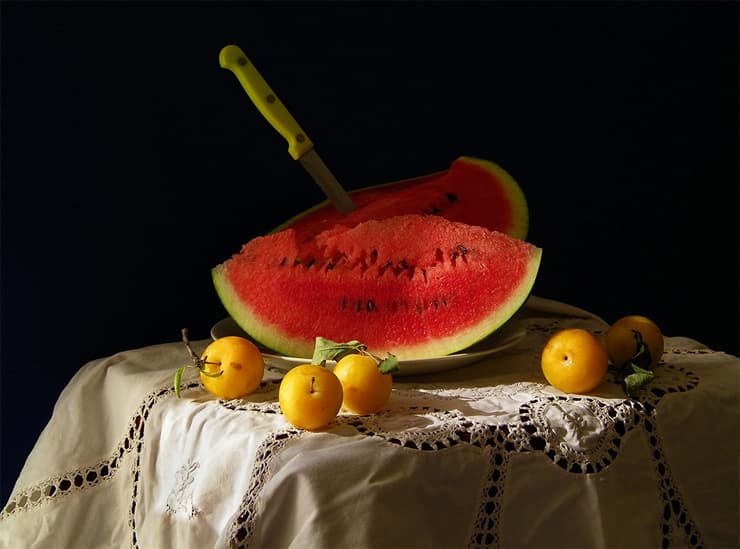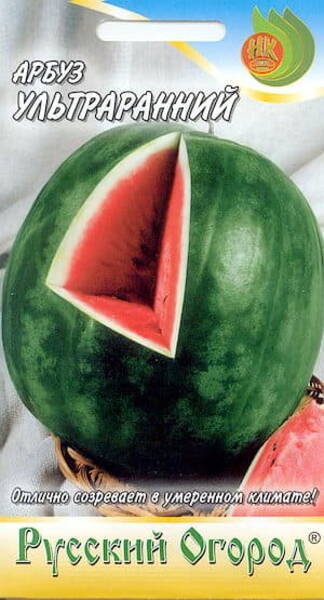Ripens well in the cool conditions of the Estonian summer.
An early-ripening variety: from germination to fruiting, it takes an average of about 80 days. The plants are compact, with limited lateral shoot development. The fruits are round, dark green, weighing 4-6 kg. The flesh is bright red, tender, grainy, and very sweet.

* Watermelon is an annual herbaceous plant of the Cucurbitaceae family. The watermelon root system begins to develop before the cotyledons emerge from the soil and reaches its full size by the time the plant blooms. It has a taproot that penetrates the soil to a depth of 1 m and is highly branched. From this main root, 15, sometimes more, lateral roots branch out, which also branch into finer rootlets. Thus, a powerful root system develops in the arable soil layer at a depth of 15-30 cm, covering up to 7-10 m³ of soil.
A unique feature of the watermelon root system is its strong suction force, capable of extracting moisture from soil at 6% humidity and even from the dry sand of the Karakum Desert. The suction force of watermelon seedlings reaches 1 MPa (10 atmospheres). This explains the plants' drought resistance and ability to thrive in poor, sandy soils.
Watermelon vines are creeping and long, reaching five meters or more in some years. They are highly branched, forming secondary lateral shoots that, in turn, branch further. The vines, especially the young shoots, are covered with long, woolly hairs that protect the plant from overheating.
The vegetative mass initially develops very slowly, while the root system grows rapidly. Twenty to thirty days after emergence, provided the weather is favorable, the plants grow rapidly, form shoots, and bloom. During this period, the growth of all shoots on a single plant can reach up to 2 meters per day.
Watermelon is a monoecious plant with dioecious flowers. Depending on the variety, watermelon seeds come in a variety of shapes, sizes, and colors.
Preparing the soil.
Sandy, humus-rich or sandy soil is very good for growing watermelons. Watermelons grown in heavy soils tend to become misshapen and have lower sugar levels. Watermelons should not be grown in the same spot year after year to avoid disease. Planting beds should be prepared to provide stable support for the fruit.
Fertilizer.
Fertilizer application should be based on soil testing; watermelons tolerate a wide range of pH, from 5.0 to 8.0. Research shows that watermelons utilize a lot of nitrogen, potassium, calcium, and phosphorus. The basic fertilizer rate is 330 kg of 10-10-20 fertilizer per hectare, which is the most suitable amount for most soils. It is recommended to apply 35 to 45 kg of nitrogen per hectare, 30 cm on each side of the plant, to prevent the growth of side shoots.
Sowing and transplanting.
The seedless method is a well-known way to grow watermelons. Place 3-4 seeds in a mound 3-4 cm deep. Plant the seeds when the danger of frost has passed. The mounds should be 1.5 m high, with 3 m between rows.
Transplanting young plants is another well-known method for growing watermelons. The seeds are placed in peat or other pots in a greenhouse (or warm beds) for germination. Transplanting occurs when there is no longer any danger of frost. Transplanting occurs before the first true leaf appears, 10-14 days after planting.
Mulching.
Covering the soil with plastic mulch warms it up faster. Warm soil is most favorable for watermelons. If using plastic mulch, prepare high-quality beds: lay plastic over the beds and cover the edges with soil. All sides should be covered to prevent wind from tearing or fraying the plastic. Punch holes in the plastic for sowing seeds and planting. Black plastic is preferable because it prevents weeds from growing under it. The soil retains moisture and nutrients, preventing leaching.
Removing braids.
Harvesting is not necessary when growing watermelons. As long as there's sufficient moisture and good pollination, watermelons thrive.
Pollination.
Male and female flowers are separated on the same plant. Bees and other insects pollinate the flowers, ensuring good fruit development. Wild bees assist in this process. However, for commercial fields, beehives should be placed nearby. Under normal conditions, one hive pollinates 1 hectare of watermelons.
Watering.
Watering should be maintained throughout the early growing season to ensure healthy plants and abundant flowering. Once the fruit has reached the desired size, watering should be reduced or avoided during the ripening season. Sugar content is typically higher and flavor is stronger if watering levels are not too high during ripening. Watermelons have a deep root system.
Pest control.
Striped and spotted cucumber beetles and melon aphids are the most dangerous pests of watermelons. It is recommended to follow planting and transplanting instructions and use insecticides to control cucumber beetles.
Fight against diseases.
Anthracnose, downy mildew, and fusarium are diseases that affect watermelons. Anthracnose and downy mildew are controlled by fungicide sprays. Fusarium cannot be controlled with chemical fungicides, so it's important to select resistant varieties.
Weed control.
Weed control is essential for producing high-quality watermelons. Sugar content can be significantly reduced if weeds shade and compete with the watermelons. Black plastic film helps control weeds early in the growth process. Where film is not available, herbicides should be used.
Cleaning.
The picker must be knowledgeable about the varieties and able to determine the degree of ripeness. Dry tendrils and the stems that attach the fruit to the vine are not an indication of ripeness. The best indicator for harvesting is uniform coloration of the watermelon, including where it touches the ground. Watermelons should be shiny. Do not leave watermelons in the sun or where they can get sunburned. Watermelons should be picked by hand very carefully, as they can be damaged. When loading, avoid piling watermelons too high, as this will crush the lower ones.












